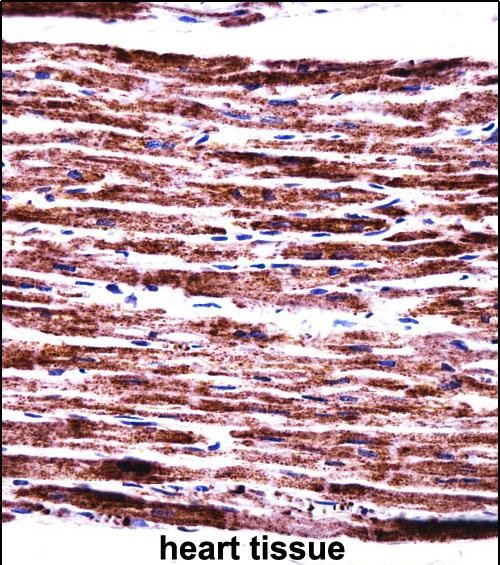PERP Antibody (C-term)
Affinity Purified Rabbit Polyclonal Antibody (Pab)
- SPECIFICATION
- CITATIONS
- PROTOCOLS
- BACKGROUND

Application
| IHC-P, WB, E |
|---|---|
| Primary Accession | Q96FX8 |
| Other Accession | NP_071404.2 |
| Reactivity | Human |
| Host | Rabbit |
| Clonality | Polyclonal |
| Isotype | Rabbit IgG |
| Calculated MW | 21386 Da |
| Antigen Region | 162-191 aa |
| Gene ID | 64065 |
|---|---|
| Other Names | p53 apoptosis effector related to PMP-22, Keratinocyte-associated protein 1, KCP-1, P53-induced protein PIGPC1, Transmembrane protein THW, PERP, KCP1, KRTCAP1, PIGPC1, THW |
| Target/Specificity | This PERP antibody is generated from rabbits immunized with a KLH conjugated synthetic peptide between 162-191 amino acids from the C-terminal region of human PERP. |
| Dilution | IHC-P~~1:10~50 WB~~1:1000 E~~Use at an assay dependent concentration. |
| Format | Purified polyclonal antibody supplied in PBS with 0.09% (W/V) sodium azide. This antibody is purified through a protein A column, followed by peptide affinity purification. |
| Storage | Maintain refrigerated at 2-8°C for up to 2 weeks. For long term storage store at -20°C in small aliquots to prevent freeze-thaw cycles. |
| Precautions | PERP Antibody (C-term) is for research use only and not for use in diagnostic or therapeutic procedures. |
| Name | PERP (HGNC:17637) |
|---|---|
| Function | Component of intercellular desmosome junctions (By similarity). Plays a role in stratified epithelial integrity and cell- cell adhesion by promoting desmosome assembly (By similarity). Thereby plays a role in barrier function of the skin against infection (By similarity). Plays a role in mammary epithelial tissue homeostasis and remodeling during and after pregnancy, potentially via its involvement in desmosome cell-cell junctions (By similarity). Required for tooth enamel development via facilitating desmosome-mediated ameloblast adhesion to the stratum intermedium during the transitional stage of amelogenesis (By similarity). May also play a role in downstream transcriptional regulation of other genes involved in amelogenesis such as AMBN, ENAM, MMP20 and KLK4 (By similarity). Plays a role as an effector in the TP53-dependent apoptotic pathway (By similarity). Positively regulates apoptosis in T-helper 17 (Th17) cell populations via caspase-dependent signaling (By similarity). Promotes neutrophil transepithelial migration in response to chemoattractants such as hepoxilin A3 (HXA3), N-Formylmethionyl-leucyl-phenylalanine (fMLP) and CXCL8/IL-8 (PubMed:25486861). Required for neutrophil transepithelial migration in response to S.typhimurium infection (PubMed:25486861). May act as a positive regulator of endothelial cell apoptosis in response to blood flow-derived shear stress (By similarity). |
| Cellular Location | Cell junction, desmosome {ECO:0000250|UniProtKB:Q9JK95}. Cell membrane; Multi-pass membrane protein. Cytoplasm. Note=Associated with desmosomes (By similarity). Colocalizes with KRT14 in the cell membrane (PubMed:31898316). Clusters in a punctate pattern throughout the epithelial cytoplasm, in response to S.typhimurium infection (PubMed:25486861). {ECO:0000250|UniProtKB:Q9JK95, ECO:0000269|PubMed:25486861, ECO:0000269|PubMed:31898316} |
| Tissue Location | Expressed in skin, heart, placental, liver, pancreas, keratinocytes and dermal fibroblasts. May translocate to the intestinal apical epithelial cell surface via sipA and sctB1/sipC- promoted exocytic translocation following infection by S. Typhimurium (PubMed:25486861, PubMed:27078059). |

Thousands of laboratories across the world have published research that depended on the performance of antibodies from Abcepta to advance their research. Check out links to articles that cite our products in major peer-reviewed journals, organized by research category.
info@abcepta.com, and receive a free "I Love Antibodies" mug.
Provided below are standard protocols that you may find useful for product applications.
Background
Component of intercellular desmosome junctions. Plays a role in stratified epithelial integrity and cell-cell adhesion by promoting desmosome assembly. Plays a role as an effector in the TP53-dependent apoptotic pathway (By similarity).
References
Bailey, S.D., et al. Diabetes Care 33(10):2250-2253(2010)
Liu, C.Y., et al. Carcinogenesis 31(7):1259-1263(2010)
Yarden, R.I., et al. Mol. Carcinog. 49(6):545-555(2010)
Talmud, P.J., et al. Am. J. Hum. Genet. 85(5):628-642(2009)
Beaudry, V.G., et al. Am. J. Med. Genet. A 149A (9), 1952-1957 (2009) :
If you have used an Abcepta product and would like to share how it has performed, please click on the "Submit Review" button and provide the requested information. Our staff will examine and post your review and contact you if needed.
If you have any additional inquiries please email technical services at tech@abcepta.com.














 Foundational characteristics of cancer include proliferation, angiogenesis, migration, evasion of apoptosis, and cellular immortality. Find key markers for these cellular processes and antibodies to detect them.
Foundational characteristics of cancer include proliferation, angiogenesis, migration, evasion of apoptosis, and cellular immortality. Find key markers for these cellular processes and antibodies to detect them. The SUMOplot™ Analysis Program predicts and scores sumoylation sites in your protein. SUMOylation is a post-translational modification involved in various cellular processes, such as nuclear-cytosolic transport, transcriptional regulation, apoptosis, protein stability, response to stress, and progression through the cell cycle.
The SUMOplot™ Analysis Program predicts and scores sumoylation sites in your protein. SUMOylation is a post-translational modification involved in various cellular processes, such as nuclear-cytosolic transport, transcriptional regulation, apoptosis, protein stability, response to stress, and progression through the cell cycle. The Autophagy Receptor Motif Plotter predicts and scores autophagy receptor binding sites in your protein. Identifying proteins connected to this pathway is critical to understanding the role of autophagy in physiological as well as pathological processes such as development, differentiation, neurodegenerative diseases, stress, infection, and cancer.
The Autophagy Receptor Motif Plotter predicts and scores autophagy receptor binding sites in your protein. Identifying proteins connected to this pathway is critical to understanding the role of autophagy in physiological as well as pathological processes such as development, differentiation, neurodegenerative diseases, stress, infection, and cancer.



